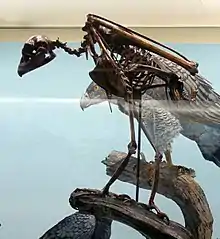| Woodward's eagle Temporal range: Upper Pleistocene, | |
|---|---|
 | |
| Skeleton from the La Brea Tar Pits | |
| Scientific classification | |
| Domain: | Eukaryota |
| Kingdom: | Animalia |
| Phylum: | Chordata |
| Class: | Aves |
| Order: | Accipitriformes |
| Family: | Accipitridae |
| Genus: | Buteogallus |
| Species: | †B. woodwardi |
| Binomial name | |
| †Buteogallus woodwardi L. Miller 1911[1] | |
Woodward's eagle (Buteogallus woodwardi) is an extinct species of black hawk that lived in North America and the Caribbean during the Late Pleistocene.[1] Remains have been found in the La Brea Tar Pits in the United States and in Cuba. Despite the common name, the species is technically a gigantic variety of hawk as it is a member of the still extant black hawk genus, Buteogallus, within the Buteoninae subfamily that are chiefly referred to as hawks, and not the Aquilinae subfamily most eagles belong to.
Description and ecology
It is one of the largest birds of prey ever found, with an estimated total length 95.6 to 110.2 cm (37.6 to 43.4 in), slightly larger than the Harpy eagle. Haast's eagle reached bigger lengths and appears to have been also more robust than Woodward's - Haast's was a forest-dwelling species.[1] Woodward's eagle appears to have hunted in open habitats, taking primarily small mammals and reptiles.[1]
It has been suggested that Buteogallus woodwardi might be particularly similar to, and was once considered to be of the same genus as species in the formerly valid solitary eagle genus, Harpyhaliaetus. The reorganization of both animals into the Buteogallus genus has furthered the comparison. Several species of extant solitary eagles sport broad wings, short but wide tails, and dark coloration across the body with noticeable crests above the occipitals which Buteogallus woodwardi might have also had. The diet of modern solitary eagles has also suggested to be broadly similar, if on a smaller scale compared to their extinct relative, with reptiles and small mammals making up a large component of food resources. Scaled up to the size of Buteogallus woodwardi, and it is likely the giant black hawk was hunting similar prey in open habitats up to the size of small deer.[2]
References
- 1 2 3 4 Suarez, William (2004). "The Identity of the Fossil Raptor of the Genus Amplibuteo (Aves: Accipitridae) from the Quaternary of Cuba". Caribbean Journal of Science. 40 (1): 120–125.
- ↑ Emslie, S.D; Czaplewski, N.J. (1999). "Two new fossil eagles from the late Pliocene of Florida and Arizona and their biogeographic implications". Smithsonian Contributions to Paleobiology. 89: 185–198.